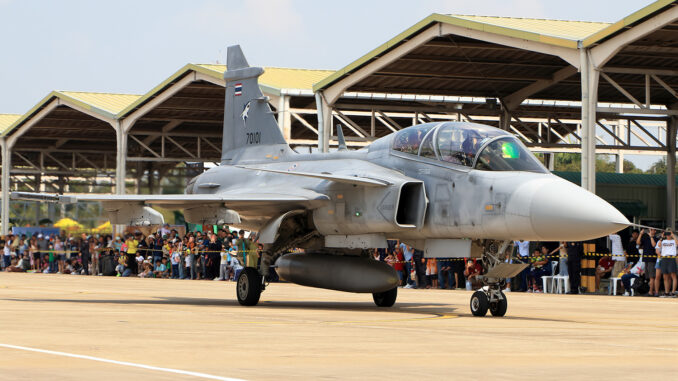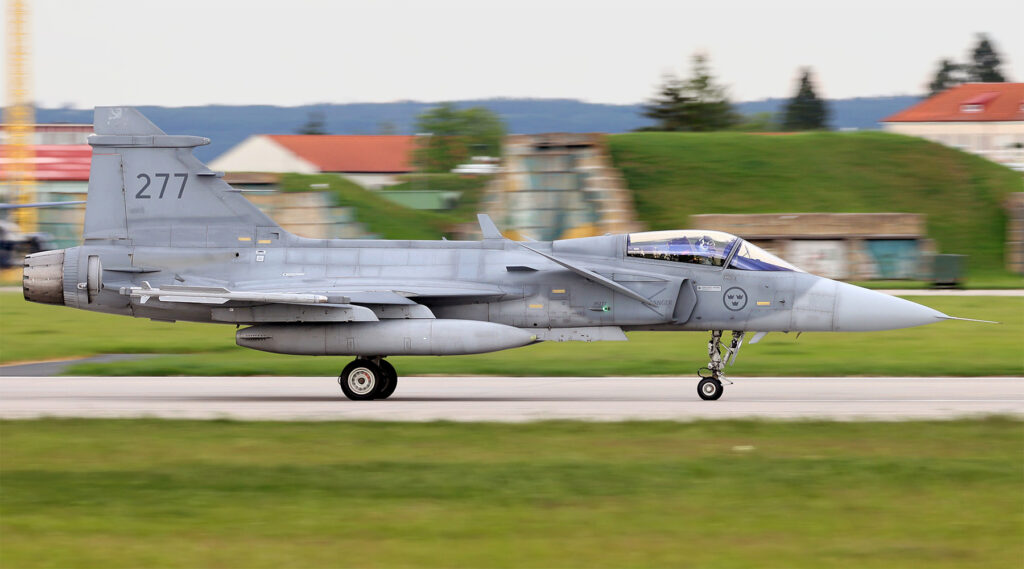
An analysis of Thailand’s decision to select the Gripen E/F as its new fighter aircraft, its strategic implications and the outlook for Saab.
Thailand has selected the Swedish Gripen E/F fighter to modernise its air fleet. The decision marks an important vote of confidence for Saab after repeated failures in the international market. With this choice, Thailand aims to strengthen its military capabilities while maintaining a diplomatic balance between the United States and China. The Gripen E/F, which is more modern and capable than its predecessors, will be essential in replacing ageing aircraft such as the F-16 and F-5. Deliveries are scheduled to begin in 2028, with an initial order for 12-14 aircraft.
Thailand’s strategic choice: why Gripen E/F?
The Royal Thai Air Force (RTAF) has made a strategic decision to select Saab’s Gripen E/F as its next fighter aircraft. The selection is the result of an extensive ten month evaluation, which concluded that Gripen E/F best meets the requirements of Thailand’s military doctrine and air strategy. Although derived from the Gripen C/D already in service in Thailand, it represents a significant technological advance. It is designed to offer improved performance in terms of stealth, range and operational versatility.
Gripen E/F is equipped with an Active Electronically Scanned Array (AESA) radar, which provides improved target detection and resistance to electronic jamming. It also features upgraded avionics and an increased capability to carry new generation weapons, such as Meteor air-to-air missiles. These features make Gripen E/F a suitable choice for Thailand as it seeks to modernise its ageing fleet and maintain its air defence capability in the face of regional threats.
The unit cost of Gripen E/F is estimated at €60 million, making it a competitive option to more expensive fighters such as the F-35. In choosing Gripen E/F, Thailand is looking for a balanced solution that combines performance and cost control, while ensuring easy integration with existing systems. In addition, Saab already has significant experience with the RTAF, having supplied the Gripen C/D and the national Link-T data link system, which facilitates the transition to the E/F model.

Implications for Thailand’s Air Fleet
The decision to acquire the Gripen E/F has direct implications for Thailand’s air fleet. Currently, the RTAF operates a mix of fighters, including 11 Gripen C/Ds, 50 F-16A/Bs, and around 34 F-5E/F Tiger IIs. However, most of these aircraft are old and require imminent replacement to maintain the operational effectiveness of the air force.
The new Gripen E/Fs are intended to replace the older F-16s, which were ordered in 1987. These aircraft, although still operational, lack the capabilities needed to deal with modern threats such as advanced anti-aircraft systems and combat drones. Replacing the F-16s with Gripen E/Fs will enable the RTAF to maintain an air force capable of meeting today’s air superiority and territorial defence requirements.
In addition, Thailand also plans to replace its F-5E/F from 2031, with a new order for 12-14 aircraft. This indicates a long-term commitment to the modernisation of its air fleet, with a gradual transition to more advanced platforms. Gripen E/F, with its modularity and ability to integrate future technology upgrades, seems a sensible choice to meet these needs.
The integration of Gripen E/F into the Thai fleet will be facilitated by the experience already gained with Gripen C/D and associated systems, such as Erieye AEW&C (Airborne Early Warning and Control). This will enable a smoother transition and a reduction in training and maintenance costs, optimising the RTAF’s operational effectiveness.
Geopolitical and diplomatic consequences of choosing Gripen
Thailand’s choice of Gripen E/F also has significant geopolitical implications. Thailand enjoys cordial relations with China, whilst seeking to strengthen its security ties with the United States. This decision to upgrade its air fleet with a Swedish fighter can be seen as a strategy to maintain a delicate balance between these two powers.
On the one hand, maintaining good relations with China allows Thailand to benefit from economic and military partnerships, while avoiding regional tensions. On the other hand, strengthening ties with the United States, notably through the Cobra Gold military exercise, underlines Thailand’s commitment to working with Western forces on security issues. The choice of the Gripen E/F, which is not subject to the same restrictions as the F-16 in terms of joint exercises with China, allows Thailand to navigate effectively between these two alliances.
By choosing Gripen E/F, Thailand also avoids sole reliance on the US for military equipment, thereby diversifying its sources of weaponry. This diversification reduces the risks associated with political or economic fluctuations, while allowing Thailand to maintain an autonomous defence capability. In addition, Gripen E/F, being a product of the European defence industry, could facilitate Thailand’s access to other European technologies, thereby strengthening its overall defence capabilities.
Prospects for Saab and the fighter market
Thailand’s choice of Gripen E/F represents a significant success for Saab, which has often been beaten by competitors such as the F-35 and F-16 in the international market. Until now, Gripen E/F has only been sold to Sweden and Brazil, with Brazil ordering 36 aircraft. This makes Thailand Saab’s second largest export customer, which could improve Saab’s prospects in other international competitions.
The fighter aircraft market is highly competitive, with major players such as Lockheed Martin and Dassault Aviation dominating the sector. However, Gripen E/F is positioning itself as a viable alternative for countries looking to modernise their air forces without investing in much more expensive fighter aircraft such as the F-35. With a competitive unit cost and advanced capabilities, Gripen E/F can attract countries looking for a good compromise between performance and cost.
Success in Thailand could also open doors for Saab in other South East Asian countries, where several air forces are looking to modernise their fleets. Growing recognition of Gripen E/F’s capabilities could encourage other nations to consider the aircraft as a viable option, especially in an environment where defence budgets are often limited. In this way, Saab could strengthen its position in the international market, building on the confidence shown by countries such as Thailand and Brazil.

A strategic choice with multiple implications
Thailand’s decision to select Gripen E/F as its new fighter aircraft reflects a carefully considered strategy to modernise its air fleet while maintaining a delicate diplomatic and geopolitical balance. Gripen E/F, with its advanced capabilities and competitive cost, offers Thailand a robust solution to modern security challenges, while strengthening its position on the international stage.
For Saab, this choice represents a validation of its product in a market dominated by giants such as Lockheed Martin. The prospect of new orders in Thailand, combined with the potential for exports to other countries, strengthens Gripen E/F’s future in the global fighter market.
The implementation of this programme will depend on final approvals from the Thai government and subsequent contractual details. However, if all goes according to plan, the RTAF will be able to start receiving its new Gripen E/F aircraft as early as 2028, marking a new era in the history of Thai military aviation.
War Wings Daily is an independant magazine.